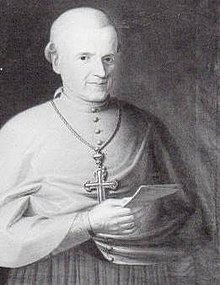Antonio Felice Zondadari (cardinal, 1740)
Antonio Felice Zondadari , also Antonio Felice Chigi Zondadari (born January 14, 1740 in Siena , † April 13, 1823 ibid) was an Italian cardinal and archbishop of Siena .
Life
He came from a noble family and was the son of Giuseppe Flavio ( Chigi ) Zondadari, Marchese of San Quirico, and his wife Violante Gori. He was a distant relative of Cardinal Antonio Felice Zondadari (1665-1737) and even more extensively related to his great-uncle Pope Alexander VII .
Zondadari graduated from the University of La Sapienza in Rome on July 23, 1768 with a doctorate as Doctor iuris utriusque . From September 20, 1764, he was a trainee lawyer at the tribunals of the Apostolic Signature . He became governor of Rieti on December 5, 1766, he was governor of Benevento from July 13, 1775 to April 1776. From 1777 to 1785 he was Apostolic Delegate and Inquisitor General in Malta . On December 23, 1780 he was ordained a deacon . He received the sacrament of ordination on March 16, 1782.
On December 19, 1785, Zondadari was appointed titular bishop of Adana . The episcopal ordination donated him two days later, Secretary of State Cardinal Francesco Saverio Zelada ; Co-consecrators were Archbishop Orazio Mattei , Canon of the Papal Basilica Santa Maria Maggiore , and Francesco Saverio Cristiani , Papal sacristan . Zondadari was appointed papal assistant to the throne and nuncio in Flanders on January 3, 1786 . Soon after, however, the Habsburg government there accused him of fighting Febronianism and supporting the agitation that followed the reorganization of the seminars there. Zondadari was expelled from the country in February 1787, first found refuge in Liège and then returned to Rome.
From March 30, 1789, Zondadari was secretary of the Congregation Propaganda Fide , a position he held until August 1795. In May 1793 he had already become vicar of the archpriest of the Vatican basilica. On June 1, 1795 he was appointed Archbishop of Siena, which he remained until his death. He received Pius VI. in his episcopal city, when the Pope was on his way to Florence after being expelled from Rome in February 1798.
In the consistory of February 23, 1801, Pope Pius VII raised him in pectore to cardinal priest , the appointment was announced in the consistory of September 28 of the same year. On December 23, 1801, Zondadari received the cardinal's hat and the titular church of Santa Balbina . He received Pius VII in Siena when he was traveling to France. Emperor Napoléon I Bonaparte appointed Zondadari chaplain to his sister Elisa Bonaparte , Princess of Lucca and Piombino . He took part in the wedding of Napoleon to Marie-Louise of Austria and was thus one of the "Red Cardinals", d. H. he was allowed to continue to wear the cardinal purple, which was forbidden to those cardinals who opposed this marriage ("black cardinals"). Zondadari took part in the "Gallican Council" of 1811.
Antonio Felice Zondadari died in 1823 and was buried in the Cathedral of Siena .
Web links
- Zondadari, Antonio Felice. In: Salvador Miranda : The Cardinals of the Holy Roman Church. ( Florida International University website), accessed January 6, 2017.
- Entry on Antonio Felice Zondadari (1740–1823) on catholic-hierarchy.org ; accessed on January 6, 2017.
| personal data | |
|---|---|
| SURNAME | Zondadari, Antonio Felice |
| ALTERNATIVE NAMES | Chigi Zondadari, Antonio Felice |
| BRIEF DESCRIPTION | Italian cardinal and archbishop and Siena |
| DATE OF BIRTH | January 14, 1740 |
| PLACE OF BIRTH | Siena |
| DATE OF DEATH | April 13, 1823 |
| Place of death | Siena |
